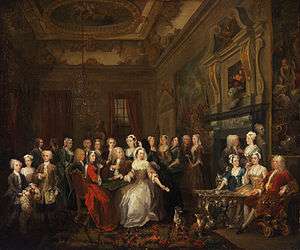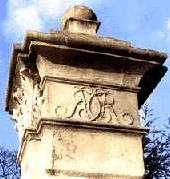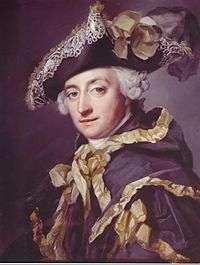Richard Child, 1st Earl Tylney


Richard Child, 1st Earl Tylney (5 February 1680-March 1750), was an English Member of Parliament. He held no Office of State, nor any commercial directorship of significance,[2] but is remembered chiefly as the builder of the now long-demolished Palladian "princely mansion"[3] Wanstead House, one of the first in the style constructed in Britain. In the furnishing of his mansion Child became the main patron of the Flemish painter Old Nollekens. He died in March 1750 aged 70 at Aix-en-Provence, France, and was buried on 29 May 1750 at Wanstead.[4]
Family background
Richard Child was baptised at Wanstead Church of the Virgin Mary on 5 February 1680, the third son of the wealthy Sir Josiah Child (1630–1699) Governor of the East India Company, who had been created 1st Baronet of Wanstead in 1678, by his third wife Emma Barnard (died 16 October 1725), daughter of Sir Henry Barnard, of Bridgnorth, Shropshire, Turkey merchant of London.[5] He was appointed as residuary legatee and executor under the will of his father, whose death occurred before Richard's majority. Richard then on 12 February 1700 petitioned Parliament for a bill, to vest certain lands in trustees ,so that settlements made upon the marriage of his half-brother Josiah could be honoured.[6]
In 1703 Richard married Dorothy Glynne, daughter and co-heiress of John Glynne, younger son of Sir John Glynne (died 1666), Lord Chief Justice, of Henley Park, Surrey, and Dorothy Tylney, daughter of Francis Tylney of Tylney Hall, Rotherwick, Hampshire. On 20 January 1704 he succeeded his half-brother Sir Josiah Child, 2nd Baronet, to the Baronetcy and to the Child manor of Wanstead, Essex, lying 6 miles north-east of the City of London. He also inherited a fortune of £4,000 per annum, which brought his total income to £10,000.[7]
Building of Wanstead House


Following the first Baronets's death, his heir Josiah had leased Wanstead to his half-brother Richard. Coming into full possession of it, Sir Richard Child, 3rd Baronet, commissioned in 1715 the Scottish architect Colen Campbell to build a palatial Palladian mansion to replace the former manor house. By the time of its completion in 1722 Wanstead House had provided Child with a grand seat befitting his newly obtained status as Viscount Castlemaine, a creation of 1718.
Political career
Sir Richard Child stood unsuccessfully as a Tory candidate for Essex in 1705, with the backing of Henry Compton, Bishop of London. In 1708 he won a seat as Member of Parliament for Maldon, Essex, as a Tory, which he retained until 1710.
During this session he came to prominence chiefly from having acted as a teller for the minority in favour of an adjournment during the debate on the Whitchurch election, which had been fought by his wife's relative, Frederick Tylney. The House resolved that Tylney had not been duly elected. He also voted against the impeachment of Dr Henry Sacheverell. He subsequently represented Essex from 1710 to 1722, having been supported in his election by the Church Party, with over 90% of his vote consisting of "Plumpers", denoting his high popularity, and was classed as a Tory in an analysis of the returns. In 1711 he was listed as one of the "Worthy Patriots" who had drawn attention to the mismanagement of the previous government. He was a member of the October Club. His elevation to the Peerage of Ireland in 1718 did not preclude him from retaining his seat in the British House of Commons. He again represented Essex from 1727 to 1734.
First elevation to the Peerage
In June 1711 a rumour emerged that Child was about to purchase a peerage for £10,000 from the administration under Queen Anne, which prompted Thomas Viscount Windsor to complain: "that's beginning too soon to be like the Duchess of Marlborough, to do anything for money, making a man that's no gentleman a lord".[8] The rumour of a peerage resurfaced in the winter of 1711 and in March 1713, and proved true when on 24 April 1718, he was raised to the Peerage of Ireland as Baron Newtown, in the County of Donegal, and Viscount Castlemaine, in the County of Kerry. It is not known whether he ever took his seat in the Irish House of Lords; the title was designed only to give social status. The title of Castlemain was somewhat discredited, having last been granted in 1661 to Roger Palmer, 1st Earl of Castlemain, whose wife was Barbara Villiers, mistress of King Charles II, to whom the King wished to give status. The patent confined the remainder to the heirs of her body, not his. Palmer himself never took his seat in the Irish Parliament, and had died in 1705.[9]
Inheritance of Tylney estates
In 1730 Child's wife Dorothy Glynne inherited the Tylney estates in Hampshire from her cousin Ann Tylney (died 5 Feb. 1729/30), Lady Craven, wife of William Craven, 3rd Baron Craven (died 1739), and daughter and sole heiress of Frederick Tylney (died 1725)[10] (who had built Tylney Hall in 1700), by Ann, daughter of George Pitt (died 1745) of Stratfield Saye, Hampshire. Lady Craven's daughter had predeceased her in 1725 and the marriage of Lord and Lady Craven was without surviving issue. Ann Tylney, Lady Craven was buried at Binley, Coventry.
Tylney family of Hampshire
In 1629 Richard Tylney purchased the manor of Rotherwick from Richard More. Tylney was already by then a local landowner. His descendant Frederick Tylney, who stood as MP for Whitchurch in January 1708, built a great mansion on the estate in 1700, called Tylney Hall. It was rebuilt in 1898 in the Victorian style, and is now a country hotel. A marble monument exists in the north aisle of Rotherwick church to Frederick Tylney (d. 1725), erected by his widow Anne, which displays their combined coats of arms, of which Tylney is: "Argent, a chevron between 3 griffons' heads erased gules".[11]
Creation of Tylney Earldom
On 11 June 1731, Viscount Castlemaine was created Earl Tylney, of Castlemaine in the County of Kerry, a title in the Peerage of Ireland. On 13 June 1733 the Earl assumed by Act of Parliament the surname, for himself and his heirs, of Tylney in lieu of his patronymic, to meet a requirement of his wife's inheritance.[12][13] His eldest surviving son Richard, styled from the creation of his father's earldom in 1731 by the courtesy title (his father's lesser title) of Viscount Castlemaine, died in 1734 without issue, predeceasing his father.
Patron of Old Nollekens

Child was the main patron of the Flemish painter Joseph Francis Nollekens, known as Old Nollekens to distinguish him from his better known sculptor son Joseph Nollekens. The following pictures by him were some of the 16 by Nollekens included in the great sale by auction held at Wanstead House in 1822 shortly before its demolition (source: catalogue, with prices realised):[14]
- Lot 10. "A pair—the Juvenile Artists and Companion, a Boy spinning his Top," £25.
- Lot 16. "A pair—the Juvenile Parties; Card-builders and Players at Tetotum," £17.
- Lot 138. "Dancing Figures, a sketch, in a French carved frame, £1 2s.
- Lot 225. "Rural Recreations, painted with all the taste and elegance of Watteau," £6 6s.
- Lot 307. "A Boy beating a Drum, and a small Landscape, and two curious models of the Stag and Fox in wax," £8, 15s.
- Lot 308. "The Wine-Traders, painted with the tasteful elegance of Watteau," £31 10s.
- Lot 3ll. "Females Bathing, in a Landscape, with a distant view of Wanstead-house," £8 18s 6d.
- Lot 314. "Landscape, Buildings," &c. £7.
- Lot 316. "Landscape and Figures, with a youth playing the guitar.
Other Nollekens paintings associated with Wanstead are:
- Music Party at Wanstead House
- Lord and Lady Tylney at Wanstead House (Longleat House Coll.)
- Music Party before the Lake at Wanstead. (Sold by Christie's 25/6/1965)
Succession

Earl Tylney and his wife Dorothy Glynne had seven children:
- Emma (b. 1707), twin. Married Sir Robert Long, 6th Baronet (d. 1767), of Draycot, Wiltshire.
- Elizabeth (b. 1707), twin.
- Frederick (b. 1709), died young.
- Richard (1711-1734), predeceased his father.
- John (b. 1712), 2nd Earl Tylney (see below).
- Josiah (d. 1760),[15] a Lieutenant or Captain in the Royal Navy, likely to be the officer depicted by Nollekens seated dressed in a blue coat.[16] He seems never to have changed his surname to "Tylney". He married Mrs Henrietta Wymondsold (1729–1763), divorced wife of Charles Wymondsold of Lockinge, Berkshire, whom she had run away from, only daughter of Robert Knight, 1st Earl of Catherlough. The marriage was without issue.[17] Both Josiah and Henrietta had their portraits painted by Francis Cotes, which are now in the collection of Lydiard Park, Swindon.
- Dorothy (b. 1717).
On the Earl's death in March 1750, he was succeeded by his eldest surviving son John, who had also adopted the surname Tylney after his elder brother Richard's death in 1734.[18] John therefore became the 2nd Earl Tylney. The 2nd Earl was MP (2nd Member) for Malmesbury, Wiltshire (1761–1768),[19] possibly as a result of his family connection with the locally influential Long family, and a Fellow of the Royal Society (1746). On his death in 1784, unmarried, the family titles all became extinct. His heir was Sir James Long, 7th. Baronet, son of his eldest sister Emma and her husband Sir Robert Long, 6th Baronet (died 1767), of Draycot, Wiltshire. The 7th Baronet was required by his inheritance to adopt the name Tylney-Long, which he duly did, becoming Sir James Tylney-Long, 7th Baronet.
References
- Hayton, David (ed.), The House of Commons 1690-1715, vol.2, p. 526. Biography of Richard Child.
- Lysons, Daniel. The Environs of London, 1796. Vol.4,pp. 231–244, Wanstead. Contains details from parish records of Wanstead Church.
- Victoria County History, Hampshire, vol.4, pp. 99–101, Tylney in Rotherwick parish. Contains genealogy of Tylney family.
- Lundy, Darryl. "FAQ". The Peerage.
- Leigh Rayment's Peerage Pages
- Robert Beatson, A Chronological Register of Both Houses of Parliament (London: Longman, Hurst, Res & Orme, 1807)
Notes
- ↑ Text based on display label at Philadelphia Museum of Art
- ↑ Hayton, David (ed.), The House of Commons 1690-1715, vol.2,p.526. "Richard Child"
- ↑ "Princely Mansion", description used in the 1822 auction sale catalogue
- ↑ http://www.thePeerage.com "Richard Tynley (sic) person no.24633
- ↑ thePeerage.com
- ↑ Hayton, 2002, p.526
- ↑ Hayton, D. (ed), 2002, p.526.
- ↑ Hayton, D. 2002, p.526
- ↑ Beddard, R. A. P. J. "Palmer, Roger". Oxford Dictionary of National Biography (online ed.). Oxford University Press. doi:10.1093/ref:odnb/21209. (Subscription or UK public library membership required.)
- ↑ Collins' Peerage, 1735, vol.3, p.306, Baron Craven
- ↑ Victoria County History, Hampshire, vol.4, pp.99-101: Tylney in Rotherwick Parish.
- ↑ Deed Poll Office: Private Act of Parliament 1732 (6 Geo. 2). c. 2
- ↑ Hayton, D., 2002, p.526
- ↑ Art Encyclopedia; & Benezit Dict. of Artists, Paris, 2006, vol.10,p.422
- ↑ Josiah is not noted by most sources except www.cracroftspeerage.co.uk "Tylney, Earl"
- ↑ "Also seated at the table is a young man thought to be a naval capt." Description of "The Nollekens Conversation Piece" by its owners, Fairfax House, York.
- ↑ Jeffares, Neil. Dictionary of Pastellists before 1800, their genealogies being given under "Cotes"
- ↑ Deed Poll Office: Private Act of Parliament 1734 (8 Geo. 2). c. 3
- ↑ Leigh Rayment's Peerage.
| Parliament of Great Britain | ||
|---|---|---|
| Preceded by John Comyns William Fytche |
Member of Parliament for Maldon 1708–1710 With: Thomas Richmond |
Succeeded by John Comyns Thomas Richmond |
| Preceded by Thomas Middleton Sir Francis Masham |
Member of Parliament for Essex 1710–1722 With: Thomas Middleton 1710–1713, 1715 Sir Charles Barrington 1713–1715 William Harvey 1715–1716 Robert Honywood 1716–1722 |
Succeeded by William Harvey Robert Honywood |
| Preceded by William Harvey Robert Honywood |
Member of Parliament for Essex 1727–1734 With: Sir Robert Abdy |
Succeeded by Thomas Bramston Sir Robert Abdy |
| Peerage of Ireland | ||
| New creation | Earl Tylney 1731–1750 |
Succeeded by John Tylney |
| Viscount Castlemaine 1718–1750 | ||
| Baronetage of England | ||
| Preceded by Josiah Child |
Baronet (of Wanstead) 1704–1750 |
Succeeded by John Tylney |